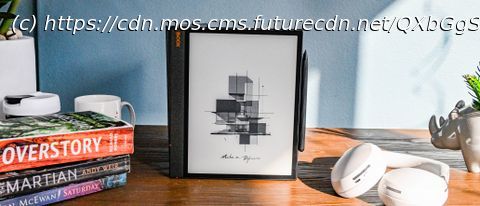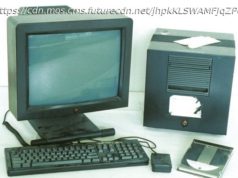Boox’s 10.3-inch Android e-paper tablet still excels at one thing in particular
Onyx Boox Note Air 3: Two-minute review
Onyx’s Boox Note Air 3 may not be the Chinese company’s thinnest e-paper tablet (having been usurped by the recently announced Boox Go 10.3), but this slim and comfortable Android device still has plenty of appeal for anyone after a flexible way to create digital handwritten notes.
With a sleek and relatively thin chassis, plus a slightly asymmetrical design, the Note Air 3 is great to hold and, despite its large size, can be comfortably supported with just one hand for both reading or writing. The monochrome E Ink Carta 1200 display is the same one used broadly across many other 10-inch epaper devices, and performs well when it comes to handwriting with the included stylus or text-based productivity and entertainment tasks. Being black and white, it’s not as geared towards highly visual tasks – images can sometimes be hard to make out – and if you’re after a device where you can highlight and mark up text with bright hues, then you’ll likely be better off with the color version – the Note Air 3 C.
With ‘Note’ right in its name, this is obviously a tablet geared towards productivity, and it’s undeniably a wiz when it comes to taking hand-written notes, with a full-featured app that allows a lot of sophistication and customization for both editing and sharing your documents. Editing features include the basics you’d expect, with a variety of notepad templates (from standard ruled lines to checklists or grid paper) and pen styles, alongside expected smart features like layers, shapes and converting handwritten notes to digital text. But beyond that, there’s advanced capabilities like being able to paste images or insert web links (or links to other on-device documents) and even record voice memos directly into notes. Note files can also optionally be saved as vector-based PDFs, then automatically synced to several cloud storage or online note-taking platforms (including Google Drive, Dropbox, Evernote, OneNote and more) for easy access on other devices.
Reading on the Note Air 3 is more of a mixed affair. While the integrated NeoReader app is admirably full featured and capably renders a variety of document and image formats (including ePub, PDF, Mobi, TXT, HTML, JPEG, PNG and plenty more) and there’s a large library of freely downloadable public domain books, there’s no ebook store from which to purchase titles. To satisfy your thirst for new titles, you’ll need to resort to third-party sources such as the Kindle or Kobo stores. If those platforms have an Android app, you can read your books in that, but otherwise you’ll need to manually copy your purchased ebooks over, either from your PC via USB or synced from a cloud storage service. (And if those ebooks happen to have digital rights management applied, then you’ll need to jump through hoops to remove that too.)
With the capacity to install Android apps straight from the Google Play Store, the Note Air 3’s capabilities can be expanded well beyond competing devices from brands like reMarkable, Kindle and Kobo – although there’s a big caveat here, in that not all of them are entirely usable on a black-and-white E Ink display. Any app that requires fast on-screen motion provides a middling experience at best – you’ll have to choose between smooth motion and significant ghosting, or juddering movement but clearer images. Certain color combinations can result in parts of user interfaces that are completely unusable too and, because tablet apps are optimized for LCD or OLED screens, on e-paper you’ll find fonts are often fuzzy or have ragged edges, lacking the sharpness of an app made with E Ink rendering in mind. The Note Air 3 fares best with high-contrast Android apps that avoid any kind of on-screen scrolling or video – which, thankfully, does include many productivity and reading apps.
Driving the Note Air 3 is a Qualcomm Snapdragon 680 processor. Although this is an aging midrange chip, it provides enough power to deliver a generally speedy and frustration-free user experience here. And the battery life is fantastic thanks to a 3,700mAh capacity, meaning that, even with daily use, it can last a minimum of a week between charges – and sometimes between 2-3 weeks when used for an hour or two per day.
When it comes to price and overall value, the Note Air 3 likewise generally impresses. At $399.99 / €449.99 (about £380) / AU$749, in most territories it’s roughly the same price as competing devices like the reMarkable 2 and Kobo Elipsa 2E, and although it’s not as polished when it comes to UX and UI, the fact that it’s running Android means it’s unmatched for versatility.
Although it’s a bit rough-and-ready in parts, the Note Air 3 is ultimately a likeable and supremely flexible and full-featured e-paper tablet. It nails note-taking and can be easily integrated with a wide range of third-party cloud and productivity platforms, so it’s an easy recommendation if those are your primary needs.Onyx Boox Note Air 3: Price and availability
Announced and shipping since December 2023
Standard bundle: $399.99 / €449.99 (about £380) / AU$749
Premium Stylus bundle: $479.98 / €529.98 (about £447) / unavailable in AU
The Note Air 3 starts at $399.99 / €449.99 (about £380) / AU$749 for the standard bundle, which includes Onyx’s basic stylus (without the eraser), five replacement stylus tips and a faux-leather folio case. In the US and Europe, you’ve also got the option to upgrade to the Premium stylus bundle for an additional $79.99 / €79.99 which, as the name suggests, adds in one of Onyx’s Pen2 Pro styluses, albeit at their normal retail price – there’s no discount being offered.
It’s worth noting that if you buy the Note Air 3 directly from Onyx or at Amazon in the US, it’s almost always discounted – during my months-long testing of the device, the US price was regularly reduced to $379.99 at the Onyx store, for example. Australians may also be better off buying the device directly from Onyx’s online store in US currency versus local retail, where there’s a considerable AU$150 mark up.
Given that discounting, the Note Air 3’s price is fairly competitive for a 10-inch note-taking e-reader – although the Note Air 3’s US price makes it more expensive than Amazon’s similar Kindle Scribe ($339.99), it matches the Kobo Elipsa 2E and reMarkable 2 (both around $399), and none of these competitors include a case, which usually adds a minimum of $50 to the price.
There’s also a color version of the Note Air 3, which costs an additional $100 / €100 / AU$170.
Value score: 3.5 / 5Onyx Boox Note Air 3: Key specsOnyx Boox Note Air 3: Design and display
Thin design that’s easy to hold one-handed
Built-in frontlights for use in dim lighting
Stylus detaches too easily
At first glance, the Note Air 3 appears very similar to its Air 2 predecessor and its two most notable upgrades are invisible ones that reside under the hood – a 20% faster processor and bigger battery (3,700mAh vs 3,000mAh). In many other respects the Air 3 is almost identical to its forebear – its 10.3-inch E Ink display uses the same generation of Carta 1200 e-paper tech with a resolution of 227 pixels per inch, and the aluminum-magnesium alloy chassis is basically indistinguishable when it comes to both looks and dimensions – although the color has been dialed down slightly, going from a dark metallic blue to a greenish gunmetal grey. The Air 3 is 40g heavier than its predecessor, coming in at 460g on our scales, with the extra weight likely due to that larger capacity battery.
While it’s not as physically wafer-thin as the 4.7mm reMarkable 2 or Onyx’s newly announced 4.6mm Boox Go 10.3, the Note Air 3 is still slim for an e-paper tablet, measuring just 5.8mm thick. And critically, that width squeezes in frontlights for screen illumination – a feature both the reMarkable and Boox Go 10.3 lack – and that makes the Note Air 3 more versatile, particularly when you’re working or reading in dimmer lighting.
If you’re tossing up between the Note Air 3 and one of Onyx’s Tab Ultras, I found the Air 3’s thinner profile and wider left-side bezel made it a considerably more comfortable device to use. That wider bezel (measuring 28mm vs the Boox Tab Ultra C’s 20mm), in particular, means it’s much easier to hold in one hand for both reading and writing, and its 5.8mm thickness means it’s a bit less obtrusive when sitting on a table too – the Tab Ultra C is 6.7mm.
Likewise, the rounded edges on all four sides mean handling the Note Air 3 is generally friendlier, although those curves do come with an unfortunate side effect: even with magnets to help hold it in place, the stylus only loosely attaches on the right edge and often sits slightly off-kilter.
Домой
United States
USA — software Onyx Boox Note Air 3 review: upgraded E Ink notetaker trades slickness...






